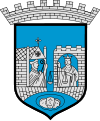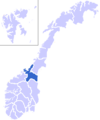Trondheim
| Trondheim kommune | |||
| — Municipality — | |||
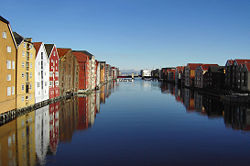 |
|||
|
|||
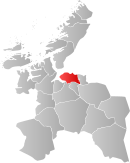 |
|||
| Coordinates: | |||
| Country | Norway | ||
|---|---|---|---|
| County | Sør-Trøndelag | ||
| District | Trondheim Region | ||
| Municipality ID | NO-1601 | ||
| Administrative centre | Trondheim | ||
| Government | |||
| - Mayor (2003) | Rita Ottervik (Ap) | ||
| Area (Nr. 258 in Norway) | |||
| - Total | 587 km² (226.6 sq mi) | ||
| - Land | 784 km² (302.7 sq mi) | ||
| Population (2009) | |||
| - Total | 166 708 | ||
| - Density | 480/km² (1,243.2/sq mi) | ||
| - Change (10 years) | 8.6 % | ||
| - Rank in Norway | 3 | ||
| Time zone | CET (UTC+1) | ||
| - Summer (DST) | CEST (UTC+2) | ||
| Official language form | Neutral | ||
| Demonym | Trondhjemmer [1] Trondheimar Trondheimer [2] |
||
|
|
|||
| Website: www.trondheim.kommune.no | |||
Trondheim (Trondhjem) is a city and municipality in Sør-Trøndelag county, Norway. The city of Trondheim was established as a municipality on 1 January 1838 (see formannskapsdistrikt). The rural municipalities of Byneset, Leinstrand, Strinda, and Tiller were merged with Trondheim on 1 January 1964.
Trondheim is a Norwegian center of education, technical and medical research with the Norwegian University of Science and Technology (NTNU) and SINTEF located in the city. NTNU has about 25,000 students. With 166,708 inhabitants (as of July 1. 2008), Trondheim is Norway's third largest municipality, as well as the centre of the fourth largest urban area, with a population of approximately 152,800 (but the real number might be closer to 175,000 (uncertain as of 2008)). As of 2008, the Trondheim Region, a statistical metropolitan area, has a population of 255,320.
Contents |
History

- For the ecclesiastical history, see Archiepiscopate of Nidaros
Trondheim was named Kaupangen (English: market place or trading place) by Viking King Olav Tryggvason in 997. Fairly soon, it came to be called Nidaros. In the beginning it was frequently used as a military retainer (Old Norse: "hird"-man) of King Olav. It was frequently used as the seat of the king, and was capital of Norway until 1217.
People have been living in the region for thousands of years as evidenced by the rock carvings in central Norway, the Nøstvet and Lihult cultures and the Corded Ware culture. In ancient times, the Kings of Norway were hailed at Øretinget in Trondheim, the place for the assembly of all free men by the mouth of the river Nidelva. Harald Fairhair (865–933) was hailed as the king here, as was his son, Haakon I – called 'the Good'. The battle of Kalvskinnet took place in Trondheim in 1179: King Sverre Sigurdsson and his Birkebeiner warriors were victorious against Erling Skakke (a rival to the throne).
Trondheim was the seat of the (Catholic) Archdiocese of Nidaros for Norway from 1152. Due to the introduction of Lutheran Protestantism in 1537, the last Archbishop, Olav Engelbrektsson, had to flee from the city to the Netherlands, where he died in present-day Lier, Belgium.
The city has experienced several major fires. Since it was a city of log buildings, out of wood, most fires caused severe damage. Great fires ravaged the city in 1598, 1651, 1681, 1708, 1717 (two fires that year), 1742, 1788, 1841 and 1842. It must be noted that these were only the worst cases. The 1651 fire destroyed 90% of all buildings within the city limits. The fire in 1681 (the "Horneman Fire") led to an almost total reconstruction of the city, overseen by General Johan Caspar von Cicignon, originally from Luxembourg. Broad avenues like Munkegaten were created, with no regard for property rights, in order to stop the next fire. At the time, the city had a population of roughly 8000 inhabitants. After the Treaty of Roskilde on 26 February 1658, Trondheim and the rest of Trøndelag, became Swedish territory for a brief period, but the area was reconquered after 10 months. The conflict was finally settled by the Treaty of Copenhagen on 27 May 1660.
During World War II, Trondheim was occupied by Nazi Germany from 9 April 1940, the first day of the invasion of Norway, until the end of the war in Europe, 8 May 1945. The home of the most notorious Norwegian Gestapo agents, Henry Rinnan, it was also subject to harsh treatment by the occupying powers, including imposition of martial law in October 1942.
Toponymy
The city was originally given the name by Olav Tryggvason. It was for a long time called Nidaros (English: Mouth of the river Nid), or Niðaróss in the Old Norse spelling. In the late Middle Ages the name was changed to Trondheim (Old Norse: Þróndheimr). In the Dano-Norwegian period, during the years as a provincial town in the united kingdoms of Denmark-Norway, the city name was spelled Trondhjem. The words heim(r) and hjem all mean "home", the word "Trond" is a tribal name, i.e. Home of the Trønders.

Following the example set by the renaming of the capital Kristiania into Oslo, Nidaros was reintroduced as the official name of the city for a brief period from 1 January 1930 until 6 March 1931. The name was restored in order to reaffirm the city's link with its glorious past, despite the fact that a 1928 referendum on the name of the city had given this result: 17,163 votes in favour of Trondhjem and 1,508 votes in favour of Nidaros.[3] Public outrage later in the same year, even taking the form of riots, forced the Storting to settle for the medieval city name Trondheim. The name of the diocese was, however, changed from Trondhjem stift to Nidaros bispedømme (English: Diocese of Nidaros) in 1918.
Historically, Trondheimen indicates the area around the Trondheimsfjord. The spelling Trondhjem was officially rejected, but many still prefer that spelling of the city's name. Today, most inhabitants still refer to their city as "Tronn-yam", where "tronn" rhymes with "gone".
The traditional German version of the city's name was Drontheim. During the Nazi German occupation, 1940–1945, the Germans made it into a major base for submarines (DORA 1) and also contemplated a scheme to build a new city of 300,000 inhabitants, Neu-Drontheim (New Trondheim), centered 15 km (10 mi) southeast of Trondheim, near the wetlands of Øysand in the outskirts of Melhus municipality. The new city — northern capital of a Germanized Scandinavia — was meant to be the future German main naval base of the North Atlantic region, and would be the largest of all German naval bases. Today, there are few physical remains of this giant construction project.[4]
Coat-of-arms and seal
- See also: Flag of Trondheim
The coat-of-arms dates back to the 13th century. To the left, there is an archbishop with his staff and mitre in a church archway. On the right, a crowned king holding scales in a castle archway. These two pictures rest on a base which forms an arch. Underneath that arch, are three male heads which symbolize the city's rank as Norway's first capital and the archbishop's place of residence. The scales symbolize justice and the motif is based on the political philosophy of the 1200s, where the balance of power between king and church was an important issue. The three heads at the bottom may symbolize the city council. The motif is unique in Norwegian municipal heraldry, but similar motifs are found in bishopric cities on the continent. The design of the coat-of-arms that was adopted in 1897, and is still used today, was made by Håkon Thorsen.[5]
Geography and climate
Trondheim is situated where the river Nidelva meets Trondheimsfjorden with an excellent harbour and sheltered condition. The river used to be deep enough for most boats in the Middle Ages. An avalanche of mud and stones made it less navigable and partly ruined the harbour in the mid-17th century.
The municipality's top elevation is the Storheia hill, 565 metres (≈1850 ft) above sea level. At summer solstice, the sun rises at 03:00 and sets at 23:40, but stays just below the horizon – there is no darkness from 20 May to 20 July.[6] At winter solstice, the sun rises at 10:00, stays very low above the horizon, and sets at 14:30.
Trondheim has a predominantly maritime climate,[7] but is mostly sheltered from the more windy conditions on the coast. The warmest temperature ever recorded is 35 °C on 22 July 1901, and the coldest is -26.1 °C in February 1899. Trondheim experiences moderate snowfall from November to March,[8] but mixed with mild weather and rainfall. There are on average 14 days each winter with at least 25 cm snow cover on the ground and 22 days with daily minimum temperature -10 °C or colder. There are often substantially more snow in suburban areas at somewhat higher elevation, such as Byåsen and Heimdal, with good skiing conditions in Bymarka. Spring often sees much sunshine, but nights can be chilly or cold. The daily high temperature can exceed 20 °C from early May to late September, but not reliably so; on average are 34 days each summer warmer than 20 °C. October is the most typical autumn month with cool temperatures and fall foliage, while November is considerably darker and colder. Average annual precipitation is 892 mm fairly evenly spread out over the year, although September and October typically sees twice as much precipitation as March, April and May. Temperatures have tended to be warmer in recent years. The Trøndelag area has seen average temperatures increase by almost 2°C the last 25 years.[9]
| Month | Jan | Feb | Mar | Apr | May | Jun | Jul | Aug | Sep | Oct | Nov | Dec | |
|---|---|---|---|---|---|---|---|---|---|---|---|---|---|
| Avg high °C | 0.1 | 1.0 | 4.1 | 7.8 | 14.1 | 17.3 | 18.4 | 17.8 | 13.6 | 9.1 | 3.7 | 1.5 | |
| Avg low temperature °C | -6.5 | -5.7 | -3.0 | 0.3 | 5.0 | 8.8 | 10.3 | 9.8 | 6.6 | 3.3 | -2.0 | -4.8 | |
| Source: World Weather Information Service All data is for Trondheim – Værnes (12 m amsl), base period is 1961–1990. | |||||||||||||

Fauna
Several wetland habitats can be found within the city limits. The Gaulosen is one of these. Here you will find a newly built observation tower and information on the birdlife that can be found.
Despite Trondheim being Norway's third largest city, wild animals can be seen. Otters and beavers thrive in Nidelva and Bymarka.[10] Badgers and foxes are not uncommon sights. Moose and deer are common in the hills surrounding the city, and might wander into the city, especially in May when the one year olds are chased away by their mothers, or in late winter when food grows scarce in the snow-covered higher regions. Since 2002, a wolverine has stayed in Bymarka.[11]
Cityscape

Most of the downtown area is scattered with small specialty stores and shops, however the main downtown shopping area is concentrated around the pedestrian street Nordre gate (English: Northern street) and the Olav Tryggvason gate.
In the mid- to late 1990s, the area surrounding the old drydock and ship construction buildings of the defunct Trondhjems mekaniske Værksted shipbuilding company at the Nedre Elvehavn (Lower River Docks) were renovated and old industrial buildings were torn down to give place for semi high-rise condominiums. A shopping mall was also built, known as Solsiden (The Sunny Side). This is a popular residential and shopping area, especially for young people.
DORA 1 is a German submarine base that housed the 13th Flotilla during the World War II occupation of Norway. Today the bunker houses various archives, among them the city archives, the university and state archives. More recently, DORA has been used as a concert venue.

Kristiansten Fortress, built 1681–1684, is located on a hill east in Trondheim. It repelled the invading Swedes in 1718, but was decommissioned in 1816 by Crown Prince Regent Charles John.
A statue of Olav Tryggvason, the founder of Trondheim, is located in the city's central plaza, mounted on top of an obelisk. The statue base is also a sun dial, but it is calibrated to UTC+1 so that the reading is inaccurate by one hour in the summer.
The islet Munkholmen is a popular tourist attraction and recreation site. The islet has served as a place of execution, a monastery, a fortress, prison, and a World War II anti-aircraft gun station.
Stiftsgården is the royal residence in Trondheim, originally constructed in 1774 by Cecilie Christine Schøller. At 140 rooms constituting 4000 m² (43000 ft²), it is possibly the largest wooden building in Northern Europe, and has been used by royals and their guests since 1800. Singsaker studenterhjem is the largest inhabited wooden building in Scandinavia as it houses 110 students throughout the school year. In the summer the student home is turned into a summer hotel, Singsaker Sommerhotell.
A statue of Leif Ericson, donated by the Leif Ericson Society in Seattle, is located at the seaside, close to the old Customs Building, the cruise ship facilities and the new swimming Hall. The statue is a replica, the original being located at a Seattle marina.
Nidaros Cathedral

The Nidaros Cathedral and the Archbishop's Palace are located side by side in the middle of the city centre. The cathedral, built from 1070 on, is the most important Gothic monument in Norway and was Northern Europe's most important Christian pilgrimage site during the Middle Ages,[12] with pilgrimage routes from Oslo in southern Norway and from the Jämtland and Värmland regions of Sweden. Today, it is the northernmost medieval cathedral in the world, and the second largest in Scandinavia.
During the Middle Ages, and again after independence was restored in 1814, the Nidaros Cathedral was the coronation church of the Norwegian kings. King Haakon VII was the last monarch to be crowned there, in 1906. Starting with King Olav V in 1957, coronation was replaced by consecration. In 1991, the present King Harald V and Queen Sonja were consecrated in the cathedral.[13] On 24 May 2002, their daughter Princess Märtha Louise married the writer Ari Behn in the cathedral.[14]
The pilgrimage route to Nidaros Cathedral, the site of Saint Olav's tomb, has recently been re-instated. In Norwegian, the route is known as Sankt Olavs vei (English: St. Olav's Way). The main route, which is approximately 640 km long, starts in Oslo and heads North, along the lake Mjøsa, up the valley Gudbrandsdalen, over the mountain range Dovrefjell and down the valley Oppdal to end at Nidaros Cathedral in Trondheim. There is a Pilgrim's Office in Oslo which gives advice to pilgrims, and a Pilgrim Centre in Trondheim, under the aegis of the cathedral, which awards certificates to successful pilgrims upon the completion of their journey.
Museums
Trondheim Museum of Arts has Norway's third largest public art collection, mainly Norwegian art from the last 150 years.[15] Sverresborg, also named Zion after King David's castle in Jerusalem, was a fortification built by Sverre Sigurdsson. It is now an open air museum, consisting of more than 60 buildings. The castle was originally built in 1182-1183, but did not last for long as it was burned down in 1188. However, the Sverresaga indicates it had been restored by 1197.
Trondheim Science Museum (Norwegian: Vitensenteret i Trondheim) is a scientific hands-on experience center. The Museum of Natural History and Archaeology is part of the Norwegian University of Science and Technology. There are also a variety of small history, science and natural history museums, such as the Trondheim Maritime Museum, the Armoury, adjacent to the Archbishops's Palace, the music and musical instrument museum Ringve National Museum, Ringve Botanical Garden, the Trondheim Tramway Museum, and the Jewish Museum (Trondheim), co-located with the city's synagogue, which is among the northernmost in the world.
Political structure
On 1 January 2005, the city was reorganized from five boroughs into four, with each of these having separate social services offices. The current boroughs are Midtbyen (44,967 inhabitants), Østbyen (42,707 inhabitants), Lerkendal (46,603 inhabitants) and Heimdal (30,744) inhabitants. Population statistics are as of 1 January 2008.
Prior to 2005, Trondheim was divided into the boroughs Sentrum, Strinda, Nardo, Byåsen and Heimdal.
| City council elections 2007 | ||||||||
| Party | Percent | Votes | Seats in council | Members of the executive board |
||||
|---|---|---|---|---|---|---|---|---|
| % | ± | total | ± | total | ± | |||
| Labour (AP) | 44.0 | 13.3 | 33184 | 12539 | 37 | 11 | 5 | |
| Progress (FrP) | 14.7 | 3.1 | 11113 | 3325 | 13 | 3 | 1 | |
| Conservative(H) | 15.0 | -5.3 | 11351 | -2365 | 13 | -5 | 2 | |
| Christian Democrat (KrF) | 3.5 | -0.1 | 2640 | 174 | 3 | 0 | 0 | |
| Centre (SP) | 2.7 | -0.4 | 2035 | -61 | 2 | -1 | 1 | |
| Socialist Left (SV) | 8.2 | -9.6 | 6170 | -5763 | 7 | -8 | 1 | |
| Liberal (V) | 4.0 | 1.2 | 3033 | 1160 | 3 | 1 | 1 | |
| Pensioners (PP) | 1.5 | -3.2 | 1145 | -2023 | 1 | -3 | ||
| Red Electoral Alliance (RV) | 3.4 | 0.7 | 2542 | 736 | 3 | 1 | ||
| Green Party (MDG) | 2.0 | 0.4 | 1522 | 435 | 2 | 1 | ||
| Democrats (D) | 0.9 | -0.1 | 662 | -3 | 1 | 0 | ||
| Turnover/Total | 60% | 75497 | 85 | 11 | ||||
| Mayor: Rita Ottervik (Ap) | Deputy mayor: Knut Fagerbakke (SV) | |||||||
| Comments: Source: Ministry of Local Government | ||||||||
Education and research

- See also the list of primary schools in Trondheim.
There are 11 high schools in the city. Trondheim katedralskole ("Trondheim Cathedral School") was founded in 1152 and is the oldest gymnasium-level school of Norway, while Brundalen videregående skole is the largest in Sør-Trøndelag with its 1100 students and 275 employees.
Trondheim is home to the Norwegian University of Science and Technology (Norges Teknisk-Naturvitenskapelige Universitet, NTNU) with its 20,000[16] students, as well as Sør-Trøndelag University College (Høgskolen i Sør-Trøndelag, HiST) with 7,000 registered students. Both NTNU and HiST receive thousands of students from all over the country, which means that the actual population of the city is somewhat higher than the official number.
The regional hospital, St. Olavs University Hospital, is located in Trondheim. The university hospital, cooperates closely with the Norwegian University of Science and Technology. A new hospital is currently being built,[17] with a projected cost of 12 billion NOK.
SINTEF, the largest independent research organisation in Scandinavia, has 1800 employees with 1300 of these located in Trondheim.[18] The Air Force Academy of the Royal Norwegian Air Force is located at Kuhaugen in Trondheim.
Transportation
Trondheim has an international airport, Trondheim Airport, Værnes, situated in Stjørdal, which is Norway's third largest airport in terms of passenger traffic.

Major railway connections are the northbound Nordlandsbanen (to Mo i Rana 1942, Fauske 1958, Bodø 1962), the eastbound Meråkerbanen (opened 1882) to Sweden via Storlien, and two southbound connections to Oslo, Rørosbanen (opened 1877) and Dovrebanen (opened 1921).
The Coastal Express ships (Hurtigruten: Covering the Bergen–Kirkenes stretch of the coast) call at Trondheim, as do many cruise ships during the summer season. Since 1994 there is also a fast commuter boat service to Kristiansund, the closest coastal city to the south.
Trondheim also boasts the northernmost tramway line in the world: the Gråkallbanen, the last remaining bit of the Trondheim Tramway is an 8.8 km (5.5 mi) route (which is mostly single-track outside the inner most parts of the city; except the stretch between Breidablikk and Nordre Hoem stations) which runs from the city centre, through the Byåsen district, and up to Lian, in the large recreation area Bymarka. Trondheim boasts the world's only bicycle lift, Trampe.
The bus network, operated by Team Trafikk, runs throughout most of the city and its suburbs. Bus service starts at about 05:00 and the latest service is around midnight. In addition, the Nattbuss (Night Bus) service ensures cheap and effective transport for those enjoying nightlife in the city centre during the weekends. E6 passes through the city centre of Trondheim in addition to a motorway bypass along the eastern rim of the city.
Culture
The main regional theatre, Trøndelag Teater, is situated in Trondheim. The theatre is the oldest theatre in Northern Europe still in use from 1816. Adresseavisen is the largest regional newspaper and the oldest active newspaper in Norway, having been established in 1767. The newspaper owns the regional television channel TVAdressa and the radio channel RadioAdressa. The two Headquarters of The Norwegian Broadcasting Corporation (NRK) are located at Tyholt in Trondheim and Oslo.
Music

Trondheim has a broad music scene, and is known for its strong communities committed to rock, jazz and classical music, the latter two spearheaded by the music conservatory at NTNU and the municipal music school, Trondheim Kommunale Musikk- og Kulturskole, with the Trondheim Symphonic Orchestra and the Trondheim Soloists being the best-known arenas. Classical artists hailing from Trondheim include violinist Arve Tellefsen, Elise Båtnes and Marianne Thorsen.
Pop/rock artists and bands associated with Trondheim include Åge Aleksandersen, Margaret Berger, DumDum Boys, Gåte, Keep Of Kalessin, Lumsk, Motorpsycho, Kari Rueslåtten, The 3rd and the Mortal, TNT, Tre Små Kinesere, The Kids, Casino Steel (of The Boys), and child prodigy Malin Reitan. The most popular punk scene is UFFA.
Georg Kajanus, creator of the bands Eclection, Sailor and DATA, was born in Trondheim. The music production team Stargate started out in Trondheim.
Sports and recreation

Trondheim is the home town of football team Rosenborg Ballklub (colloquially known as RBK), a successful team nationally as well as internationally[19] playing in the UEFA Champions League for the 11th time in 2007.[20] The team's name, and initially most of its players, came from an east-end borough.
The city is also known for its active winter sports scene, with cross-country skiing tracks in Bymarka and a ski jumping arena in Granåsen, as well as nearby alpine skiing facilities at Vassfjellet. Trondheim hosted the 1997 Nordic skiing World Championships, held World Cup ski sprint races in the city centre in February 2004, and hosted the 2006 National Biathlon Championships. In March 2007, Trondheim lost the bid to Tromsø to be the Norwegian candidate in the contest to host the 2018 Winter Olympics.[21]
Trekking and cross-country skiing are popular among Norwegians. In Trondheim, people often go to the hills surrounding the city – Bymarka in the west and Estenstadmarka in the east - to engage in these activities. Many kilometers of prepared skiing tracks are available during the winter, as are a few establishments serving food and beverages in the middle of the forested skiing areas.[22]
Mountain hiking is also popular, and several mountain ranges are within short distance from the city. Trollheimen is located to the southwest, Dovrefjell to the south and Sylane to the east. There is an 9-hole Golf course bordering Bymarka, Trondheim Golfklubb, and an 18 hole course at nearby Byneset.
Salmon fishing is a popular activity. The record in Nidelva is 31.8 kg.[23] Gaula, one of the best salmon rivers in Europe,[24][25][26][27] empties into Gaulosen at Leinstrand in Trondheim municipality, south of the city center.
Student culture

With students comprising almost a fifth of the population, the city of Trondheim is heavily influenced by student culture. Most noticeable is Studentersamfundet i Trondhjem, the city's student society. It's characteristic round, red building from 1929 sits at the head of the bridge crossing the river southwards from the city centre.
Student culture in Trondheim is characterized by a long-standing tradition of volunteer work. The student society is for example run by more than 1200 volunteers[28]. NTNUI, Norway's largest sports club, is among the other volunteer organizations that dominate student culture in Trondheim. Students of Trondheim are also behind two major Norwegian culture festivals, UKA and The International Student Festival in Trondheim (ISFiT). NTNU lists over 200 student organizations with registered web pages at its servers alone[29]
In an effort to bring attention to the strong student culture of Trondheim, the organization StudiebyEN (Student City One) in 2004, launched a "love guarantee" that attracted worldwide attention. The notion of Trondheim as a romantic city appears to have stuck with its image.[30][31][32]
Twin cities
Trondheim has several twin cities. They are:[33]
 Darmstadt, Germany
Darmstadt, Germany Dunfermline, Fife, Scotland, UK
Dunfermline, Fife, Scotland, UK Graz, Austria
Graz, Austria Kópavogur, Iceland
Kópavogur, Iceland Östersund, Sweden
Östersund, Sweden Norrköping, Sweden
Norrköping, Sweden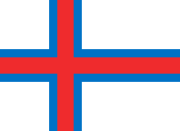 Klaksvík, Faroe Islands
Klaksvík, Faroe Islands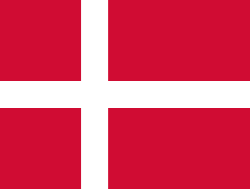 Odense, Denmark
Odense, Denmark Petah Tikva, Israel
Petah Tikva, Israel Ramallah, Palestinian territories
Ramallah, Palestinian territories Split, Croatia
Split, Croatia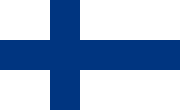 Tampere/Tammerfors, Finland
Tampere/Tammerfors, Finland Tiraspol, Moldova (
Tiraspol, Moldova ( part of de facto independent Transnistria)
part of de facto independent Transnistria) Vallejo, California, USA
Vallejo, California, USA Keren, Eritrea (twinned with the Trondheim borough of Heimdal)
Keren, Eritrea (twinned with the Trondheim borough of Heimdal)
Notable citizens
- Hjalmar Andersen, former speed skater, three times gold medalist in the 1952 Winter Olympics, world champion, European champion and Norwegian champion three concecutive years 1950–1952, and five times world record holder. He grew up in Trondheim.[34]
- Arve Tellefsen, solo violinist, born in Trondheim 1936.[34]
- Liv Ullmann, twice Oscar-nominated actress, film director and honorary doctor at NTNU. She was born in Tokyo (1938), and grew up in Trondheim.
See also
- List of mayors of Trondheim
References
- ↑ "Trondhjemmer". www.trondheim.com. Retrieved on 2008-01-09. (Norwegian)
- ↑ "Personnemningar til stadnamn i Noreg". Språkrådet. (Norwegian)
- ↑ Bratberg, Terje T. V. (10 January 2008). "Striden om bynavnet", Arbeideravisa (Trondheim), p. 27. (Norwegian)
- ↑ Hitlers drøm om Trondheim (Norwegian)
- ↑ "Trondheim's coat of arms and seal". Trondheim kommune. Retrieved on 2008-10-29.
- ↑ Trondheim, Norway - Sunrise, sunset, dawn and dusk times for the whole year - Gaisma
- ↑ World Weather Information Service - Trondheim
- ↑ "See Norway's snow, weather, water and climate anytime anywhere". Retrieved on 2007-12-29.
- ↑ "Nyhet fra Meteorologisk institutt". met.no (27 November 2007). (Norwegian)
- ↑ "Bymarkbeveren skal holdes i sjakk". Retrieved on 2007-08-03. (Norwegian)
- ↑ "Jerven som flyktet til byen". Retrieved on 2008-05-09. (Norwegian)
- ↑ "Pilgrim ways in Norway, background". Trondheim kommune. Retrieved on 2007-08-04.
- ↑ "The consecration of King Harald and Queen Sonja". The Norwegian Royal Family. Retrieved on 2007-08-03.
- ↑ "The wedding of Princess Märtha Louise". The Norwegian Royal Family. Retrieved on 2007-08-03.
- ↑ http://www.tkm.museum.no/no/velkommen.html
- ↑ "NTNU – Facts and figures". Retrieved on 2007-11-01.
- ↑ The Hospital Development Project for Central Norway
- ↑ About us – SINTEF
- ↑ "Club facts: Rosenborg". Retrieved on 2007-09-22.
- ↑ "Club facts: Rosenborg". Retrieved on 2007-09-22.
- ↑ "Pressemelding vedr. valg av Tromsø som mulig norsk søkerby til OL og Paralympic 2018". Retrieved on 2007-10-28. (Norwegian)
- ↑ http://home.online.no/~sbosta/Hytter_i_Trondheimsmarka,Tekst.htm Hytter i Trondheimsmarka
- ↑ Trondheim – the official website – outdoor activities
- ↑ Gaula River, Trondheim, Norway, fishing guides, fly fishing, salmon
- ↑ Fishmaster Global Fishing - Fly Fishing - Norway - Gaula
- ↑ Gaula < Norway < English < Vefsvæði lax-a.is
- ↑ FT.com / Home UK / UK - Norwegian salmon rivers
- ↑ "About Studentersamfundet". Retrieved on 2008-02-18. (Norwegian)
- ↑ "NTNU Student Organizations (in Norwegian". Retrieved on 2008-02-18.
- ↑ "StudiebyEN: Love guarantee". Retrieved on 2008-02-18.
- ↑ "Bergensavisen: Studenter får kjærestegaranti". Retrieved on 2008-02-18. (Norwegian)
- ↑ "Telegraph.co.uk: Students are offered course of true love". Retrieved on 2008-02-18.
- ↑ Trondheims offisielle nettsted - Vennskapsbyer
- ↑ 34.0 34.1 "Formidabel festuke". Trondheim kommune. Retrieved on 2007-08-05. (Norwegian)
External links
- Municipality website (Norwegian)
- Trondheim.no, Trondheim's official website in Norwegian and English
- Trondheim travel guide from Wikitravel
- Trondheimsbilder – Historical photographs of sights and people in Trondheim
|
|||||
|
||||||||||||||||||||||||||||||||||||||||||||||||||||||||||||||||||||||||||||||||||||||||
